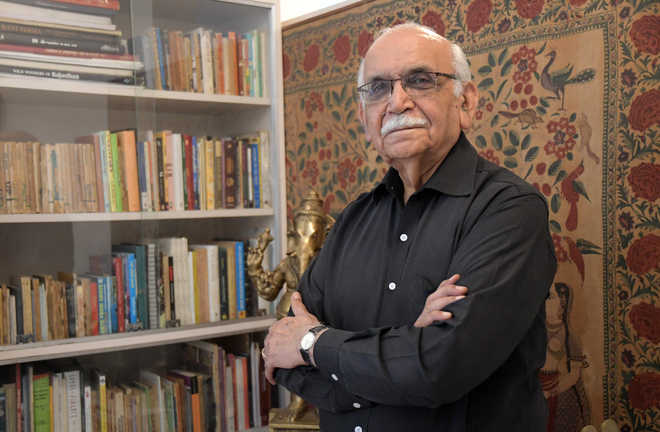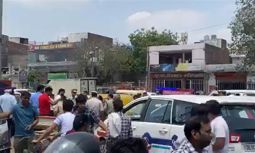
BN Goswamy Photo by Ravi Kumar
Sarika Sharma
The sun was setting, spreading its golden light across the town. The fourth day was drawing to an end and BN Goswamy had failed to find headway. Surrounded by heavy bahis (ledgers) of pandas, he was sitting at the bank at Surajkund, skimming through the pages. He was here to find out about painters from Samloti village. The family had died out. A reference had convinced a panda handling Kangra villages to allow the researcher to see the bahis. After checking thousands of entries, he suddenly saw those three words he had been looking for: Chitere Samloti Ke; Painter from Samloti. Goswamy knew that if one entry by a painter existed, there would be several others and he would find them. His unusual source of gathering information was to change the historiography of art.
For the next three years, Goswamy visited various places — from Haridwar and Pehowa to Kashmir and Benaras — wherever people from Kangra went to perform the last rites of their family members. The information gathered thus enabled him to reconstruct detailed genealogies of several families of Pahari artists with a great deal of accuracy. He also brought out that the family followed the same artistic style and that their art was not defined by the ‘school’ or ‘centre of production’. Until then it was believed that Basholi, Garhwal, Kangra were styles followed by painters. His research established that style was not specific to a region, but evolved in a family, just like a gharana in music — in this case that of Pandit Seu. His style was followed by sons Nainsukh and Manaku — whom Goswamy, professor emeritus at Panjab Universiy, has dedicated a book each — and their sons and grandsons.
These artists were spread over the princely states of Punjab hills and across Garhwal and Kashmir. The study, based on this source, besides the information that was in oral tradition and the settlement records of Kangra district prepared by the British revenue officers, was published in the September issue of Marg magazine, then edited by author Mulk Raj Anand, in 1968. The piece was titled Pahari Painting: The Family as the Basis of Style. The entire issue was devoted to just this one monograph.
******
In 1958, Goswamy had given up his coveted career in the IAS. A few months later, he went to the office of Prof Hari Ram Gupta at Panjab University for pursuing PhD. History was then more about politics and economics. There was no third option to choose from. Goswamy, however, was interested in neither of these. At the time of leaving IAS, his friends had gifted him a book on Pahari paintings by MS Randhawa. He read it during his train journey home and felt drawn to Pahari paintings. Goswamy wanted to work on the religious and social background of the painters.
Prof Gupta asked him to give him names of three people who had worked in the field. Goswamy rattled off the names of AL Basham, WG Archer and Karl Khandelwal. Gupta wrote letters to the three telling them about this ‘crazy young man’ who had shown interest in working on that unusual topic. The three immediately responded, saying that the topic should indeed be taken up. For three years, he went from place to place in the hills, travelling through villages to know more about how they lived and the culture of those places.
After completion of his PhD, he was visiting the Victoria & Albert Museum in the UK when he spotted a nameplate outside a room reading: WG Archer, Keeper of the Indian Section. Archer was a famous historian of Pahari painting. Goswamy walked into his office. “Archer immediately took a liking to me and invited me home,” recalls Prof Goswamy. Archer was a retired ICS officer but did not know any Indian script. On the other hand, Goswamy had learnt Tankri, the Pahari script, during his research. Archer gave him an inscription from a painting by Nainsukh, the Pahari painter. “I did not want to make a mistake and told him I would get back. Towards the end was written: Eh tasveer Nainsukhe Jasrote Likhi Thi, meaning: This painting was made by Nainsukh at Jasrota.” When Goswamy told this to Archer, he started jumping with joy. The inscription had been published in 1950 and archaeologist B Ch Chhabra had written that Nainsukh of Jasrota had made the painting. Chhabra had committed a minor, but critical mistake.
Goswamy felt a little more confident about himself. That evening, as Archer bade goodbye to his guest, he said in his typical British manner: “Wish we knew more about these wretched artists.” That statement stayed with Goswamy and he decided to unearth more on Pahari painters. It is another story that the answer negated Archer’s body of work and marked a new paradigm in art history, much to the historian’s chagrin.
Praise flowed in too, from Stella Kramrisch, Milo C Beach. Founded in 1948 by MR Anand and supported by Tata, Marg was an important magazine for art historians. The essay carried an introduction by Anand. “He had gone on writing about Kangra and Basholi paintings, in complete disregard for my research,” laughs Prof Goswamy.
Years later, Beach, director of Sackler Art Gallery, Washington, organised a one-day seminar, Goswamy vs. Archer. Art historians had, by then, begun to take serious cognisance of the paradigm shift that the work had brought about. Prof Goswamy says it had remained not a matter of Pahari painting alone. Art historians everywhere noticed that this was another way of looking at styles. And perhaps rewrite histories too…




























